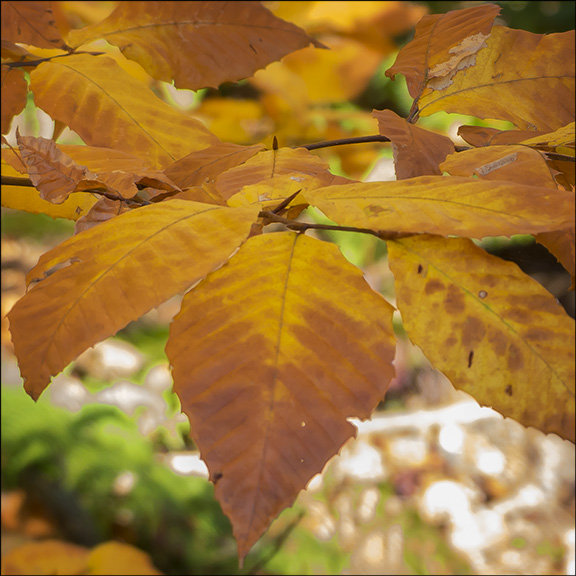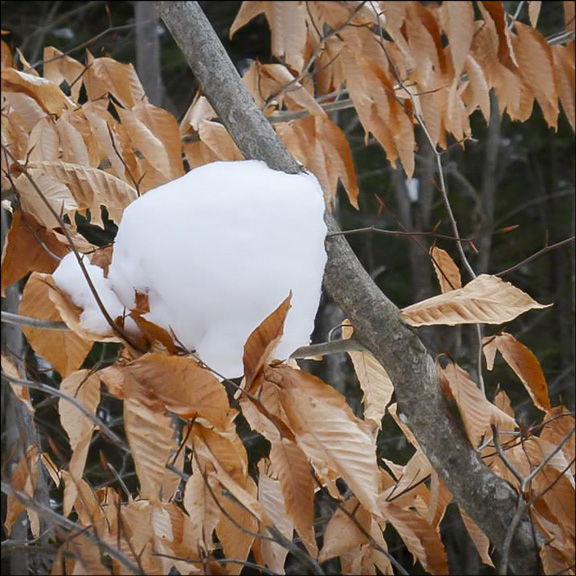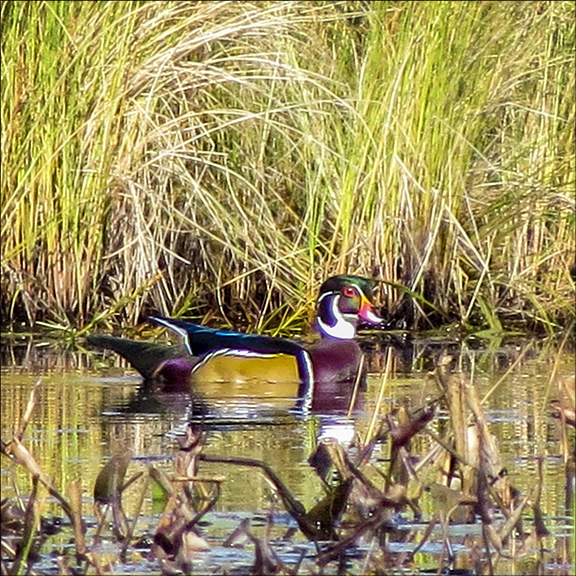Trees of the Adirondacks:
American Beech (Fagus grandifolia)
 Trees of the Adirondacks: American Beech leaves have widely-spaced, pointed teeth. American Beech on the Barnum Brook Trail (25 July 2012)
Trees of the Adirondacks: American Beech leaves have widely-spaced, pointed teeth. American Beech on the Barnum Brook Trail (25 July 2012)
| This page is no longer being updated. For an updated and expanded version of this material, see: American Beech (Fagus grandifolia) |
The American Beech (Fagus grandifolia) is a large, deciduous tree that grows in the Adirondack Mountains and flourishes in well-drained areas of the VIC, often near Sugar Maples. The American Beech is also known as North American beech. It is the only native species of beech which grows in North America; the European Beech was introduced from Europe and is a popular landscaping tree.

Identification of the American Beech: This tree normally grows from 50 to 70 feet tall, with a rounded crown. The tree is often surrounded by suckers. The branches sprout in alternate fashion. The leaf arrangement is also alternate. That is, only one leaf occurs at a node. The leaves of the American Beech are elliptical, with pointed tips, and have many straight, parallel veins and coarse teeth. The leaves are green during the summer, turning golden yellow, lustrous brown, then pale brown in autumn. They remain on the tree well into winter. The bark of both trunk and larger branches is smooth and light gray, somewhat mottled. The bark of twigs is green at first, becoming mottled gray to brownish at maturity.
Keys to identifying the American Beech and differentiating it from other deciduous trees and large shrubs include its leaves, bark, growth habit, and habitat.
- The leaves of the American Beech are similar in shape to those of the Paper Birch and Yellow Birch; and the leaves of all three species are toothed. However, leaves of birch trees are double toothed, meaning that the teeth are of different sizes, with small teeth along the contours of larger teeth. American Beech leaves, by contrast, are single-toothed, with teeth of the same size. Moreover, the bark of the American Beech is very different from that of the peeling bark of the Paper Birch and Yellow Birch.
- The bark of American Beech trees and those of the Red Maple and young Sugar Maple trees are similar, but the shape of American Beech leaves contrast sharply with the lobed leaves of the Red Maple, Sugar Maple, and other maples. Moreover, maple leaves are opposite, with two leaves attached on either side of a node. By contrast, the leaf arrangement of American Beech trees is alternate, with only one leaf occurring at every node.
- The bark of the American Beech contrasts with the white or bronze peeling park of the Paper Birch and Yellow Birch.
- In contrast to maple and birch trees, American Beech trees generally retain their leaves throughout the winter, making this tree very easy to identify in the snowy woods.
- American Beech leaves are similar in shape to those of the Hobblebush, but Hobblebush leaves have much finer teeth; and the growth pattern is very different. The Hobblebush is a shrub and rarely exceeds 10 feet in height.

American Beech trees flower during the spring, at a time when the leaves are about one-third grown. The bloom period lasts about one week; the flowers are cross-pollinated by the wind. The male flowers are yellowish-green male flowers and hang in clusters on long stems.
The fruit of the American Beech is a four-part husk with hooked prickles, opening at maturity to reveal two or three small, triangular nuts. They ripen between September and November. Beech trees produce large crops of fruits every two to eight years. The distinctive winter buds of beech trees are up to ¾" long and narrowly ellipsoid in shape.
Uses of the American Beech: The quality of wood is only fair, but it has been used for cheap furniture, tool handles, veneer, shoe lasts, flooring, containers, veneer, railroad ties, baskets, pulp, wooden-ware, and fuel. The leaves and bark can be used to make dyes.

The tree also has a number of edible uses. Young leaves can be used raw or cooked as a potherb. Beechnuts can be roasted and eaten or used a coffee substitute. The raw seed should not be eaten in large quantities. However, the seed can be dried and ground into a powder, then used with cereal flours in making bread and cakes. The inner bark can be dried, ground into a powder, and then used as a thickening in soups or mixed with cereals when making bread. Early settlers gathered beech nuts to extract the oil, which is similar to olive oil and was used as both food and lamp oil.
American Beech was used by various native American tribes to treat a variety of ailments, including pulmonary troubles, burns, scalds, sores, and poison ivy. Many native American tribes used the nuts for food. The Iroquois, for instance, crushed and boiled fresh nut meats, using the liquid as a drink; they also used the crushed nuts in a mixture with cornmeal and beans to make bread.

Wildlife Value of the American Beech: Beech nuts are an important source of food for wildlife, including Raccoons, White-tailed Deer, Porcupines, and Foxes. The nuts are a vital food source to squirrels and chipmunks. A poor mast year will visibly thin their population. Eastern Chipmunks store beechnuts deep in underground burrows. Red Squirrels bury large and small caches of the nuts or store them in burrows, brush piles, or stone walls. Beechnuts are also consumed by Black Bears, who load up on calories for winter hibernation. This tree is the caterpillar host for the Early Hairstreak butterfly.
The American Beech also provides food and nesting sites for a variety of birds. It was the tree most associated with the extinct Passenger Pigeon, which fed on its nuts and roosted in its branches. The buds and blossoms of American Beech trees are an important part of the early spring diet of White-throated Sparrows. The species is a preferred foraging site for Hairy Woodpeckers. American Beech are used as a nest site by Cooper's Hawks and American Redstarts. American Beech trees provide nest cavities for cavity nesters, like the Wood Duck. Beechnuts an important food source for Blue Jays, Red-headed Woodpeckers, White-breasted Nuthatches, and Red-bellied Woodpeckers.

The American Beech is a common tree species in the breeding habitat of a variety of birds, including :
- Wood Thrush
- Veery
- Hooded Warbler
- Canada Warbler
- Acadian Flycatcher
- Black-throated Blue Warbler
- Northern Saw-whet Owl
Distribution of the American Beech: American Beech is found in the eastern part of the US, within an area from Cape Breton Island, Nova Scotia west to Maine, southern Quebec, southern Ontario, northern Michigan, and eastern Wisconsin; then south to southern Illinois, southeastern Missouri, northwestern Arkansas, southeastern Oklahoma, and eastern Texas; east to northern Florida and northeast to southeastern South Carolina.
This species is one of the indicator species of the Northern Hardwood Forest. It also occurs in mixed hardwoods with Sugar Maple, birch, and hemlock. American Beech trees do best in well-drained upland sites. In New York State, the American Beech occurs from sea level in coastal Long Island to high elevation forests in the mountains of northern New York.
American Beech at the Paul Smiths VIC: The American Beech does not grow in the VIC's wetland areas, such as Heron Marsh and Barnum Bog. Like the Sugar Maple, the American Beech does not flourish in moist soils, so look for it in upland areas. The Jenkins Mountain Trail and the south side of Heron Marsh are good places to look for Americn Beech. The most convenient place to observe the American Beech is on the Barnum Brook Trail This species is one of the eleven tree species marked with signage along this trail. The American Beech is on the right-hand side of the trail, near the gazebo and just beyond the Sugar Maple, providing a convenient way of identifying the preferred habitat of these trees.
References
- United States Department of Agriculture. Forest Service. Silvics of North America. American Beech. Retrieved 31 January 2015.
- United States Department of Agriculture. Plants Database. Retrieved 31 January 2015.
- Lady Bird Johnson Wildflower Center. Native Plant Database. Retrieved 31 January 2015.
- University of Wisconsin. Trees of Wisconsin. Fagus grandifolia. Retrieved 31 January 2015.
- Online Encyclopedia of Life. Fagus grandifolia. Retrieved 31 January 2015.
- University of Wisconsin. Robert W. Freckmann Herbarium. Retrieved 31 January 2015.
- New York Flora Association. New York Flora Atlas. Retrieved 31 January 2015.
- University of Michigan. Native American Ethnobotany. A Database of Foods, Drugs, Dyes and Fibers of Native American Peoples, Derived from Plants. Retrieved 31 January 2015.
- Plants for a Future. Database. Retrieved 31 January 2015.
- The Birds of North America. Purple Finch, Veery, Hooded Warbler, Wood Thrush,Canada Warbler, Acadian Flycatcher, Black-throated Blue Warbler, Northern Saw-whet Owl, White-throated Sparrow, Hairy Woodpecker, Cooper's Hawk, Wood Duck, Blue Jay, Red-headed Woodpecker, White-breasted Nuthatch, Red-bellied Woodpecker, and American Redstart. Subscription Web Site. Retrieved 31 January 2015.
- Trees of the Northern Forest Trail Walk
- Ellen Rathbone, "Adirondack Tree Identification 101," The Adirondack Almanack, 18 November 2009. Retrieved 31 January 2015.
- Ellen Rathbone, "Adirondack Tree Identification 102," The Adirondack Almanack, 18 November 2009. Retrieved 31 January 2015.
- Paul Smith’s College VIC. Barnum Brook Tree Game.
- Michael Wojtech. Bark: A Field Guide to Trees of the Northeast (UPNE, 2011).
- George A. Petrides. A Field Guide to Eastern Trees (Boston: Houghton Mifflin Company, 1998), pp. 96-97, 306.
- George A. Petrides. A Field Guide to Trees and Shrubs (Boston: Houghton Mifflin Company, 1958,1972), pp. 10, 263, 348-349.
- Gil Nelson, Christopher J. Earle, and Richard Spellenberg. Trees of Eastern North America (Princeton : Princeton University Press), pp. 300-301.
- C. Frank Brockman. Trees of North America (New York: St. Martin's Press), pp. 114-115.
- Keith Rushforth and Charles Hollis. Field Guide to the Trees of North America (Washington, D.C., National Geographic, 2006), p. 116.
- National Audubon Society. Field Guide to North American Trees (New York: Alfred A. Knopf, 1980), Plates 152, 528, 601, 614, pp. 380-381.
- Allen J. Coombes. Trees (New York: Dorling Kindersley, Inc., 1992), p. 151
- John Kricher. A Field Guide to Eastern Forests. North America (Boston: Houghton Mifflin, 1998), pp. 72-75.
- Alexander C. Martin, Herbert S. Zim, and Arnold L. Nelson. A Guide to Wildlife Food Habits (New York: Dover Publications, 1951), pp. 306-307.
- Bruce Kershner, et al. National Wildllife Federation Field Guide to Trees of North America (New York: Sterling Publishing Co., 2008), p. 414.
- John Eastman. The Book of Forest and Thicket. Trees, Shrubs, and Wildflowers of Eastern North America (Harrisburg, Pennsylvania, 1992), pp. 18-23.
- David Allen Sibley. The Sibley Guide to Trees (New York: Alfred A. Knopf, 2009), pp.172-173.
